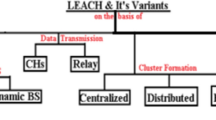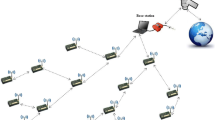Abstract
Mobile Ad-Hoc Networks (MANETs) are useful and appropriate, especially for complex scenarios, including law, military enforcement as well disaster recovery, and emergency rescue. Among different cryptographic algorithms, there is a chance of data hacking according to random key generation. The major purpose of this work is to plan and implement a new security protocol in MANET that is applicable for IoT platforms. The approach focused on this research is the modified chaotic map for encryption and decryption to deal with MANET and IoT data. The privacy preservation model is designed with a suggested cryptographic algorithm for enhancing the privacy and security of the MANET and IoT. An enhanced chaotic map is developed for processing the key generation that maintains the encryption and decryption process and prevents the loss of data while recovering the data. The adaptive key management strategy under the chaotic map is developed in this paper using a hybrid meta-heuristic algorithm named Crow Harris Hawks Search Optimization (CHHSO). Finally, the security analysis and performance evaluation in comparison is made in terms of “statistical analysis, convergence analysis, and communication overhead” that show the improved performance of the proposed model.








Similar content being viewed by others
Data availability
No new data were generated or analysed in support of this research.
References
Muthusenthil, B., & Murugavalli, S. (2017). Privacy preservation and protection for cluster based geographic routing protocol in MANET. Wireless Networks, 23, 79–87.
Wu, Y., Ma, Y., Dai, H.-N., & Wang, H. (2021). Deep learning for privacy preservation in autonomous moving platforms enhanced 5G heterogeneous networks. Computer Networks, 185, 107743.
Chikouche, N., Cayrel, P.-L., Mboup, E. H. M., & Boidje, B. O. (2019). A privacy-preserving code-based authentication protocol for Internet of Things. The Journal of Supercomputing, 75, 8231–8261.
Manjula, R., & Datta, R. (2018). A novel source location privacy preservation technique to achieve enhanced privacy and network lifetime in WSNs. Pervasive and Mobile Computing, 44, 58–73.
Sharavanan, P. T., Sridharan, D., & Kumar, R. (2018). A privacy preservation secure cross layer protocol design for IoT based wireless body area networks using ECDSA framework. Journal of Medical Systems. https://doi.org/10.1007/s10916-018-1050-2
Loretta, G. I., & Kavitha, V. (2021). Privacy preserving using multi-hop dynamic clustering routing protocol and elliptic curve cryptosystem for WSN in IoT environment. Peer-to-Peer Networking and Applications, 14, 821–836.
Devi, P., Sathyalakshmi, S., & Subramanian, D. V. (2021). An optimal metaheuristic optimization based ElGamal public key cryptosystem for privacy in IoT environment. International Journal of System Assurance Engineering and Management. https://doi.org/10.1007/s13198-021-01173-0
Gheisari, M., Najafabadi, H. E., Alzubi, J. A., Gao, J., Wang, G., Abbasi, A. A., & Castiglione, A. (2021). OBPP: An ontology-based framework for privacy-preserving in IoT-based smart city. Future Generation Computer Systems, 123, 1–13.
Zhou, C., Wang, T., Tian, H., Jiang, W., & Wang, Z. (2020). A top-K query scheme with privacy preservation for intelligent vehicle network in mobile IoT. IEEE Access, 8, 81698–81710.
Lalos, A. S., Vlachos, E., Berberidis, K., Fournaris, A. P., & Koulamas, C. (2020). Privacy preservation in industrial IoT via fast adaptive correlation matrix completion. IEEE Transactions on Industrial Informatics, 16(12), 7765–7773.
Fragkos, G., et al. (2021). Enhancing privacy in PUF-cash through multiple trusted third parties and reinforcement learning. ACM Journal on Emerging Technologies in Computing Systems (JETC), 18(1), 1–26.
Aman, M. N., Basheer, M. H., & Sikdar, B. (2019). Data provenance for IoT With light weight authentication and privacy preservation. IEEE Internet of Things Journal, 6(6), 10441–10457.
Xu, X., He, C., Xu, Z., Qi, L., Wan, S., & Bhuiyan, M. Z. A. (2020). Joint optimization of offloading utility and privacy for edge computing enabled IoT. IEEE Internet of Things Journal, 7(4), 2622–2629.
Dai, M., Li, J., Su, Z., Chen, W., Xu, Q., & Fu, S. (2020). A privacy preservation based scheme for task assignment in internet of things. IEEE Transactions on Network Science and Engineering, 7(4), 2323–2335.
Punithavathi, P., & Geetha, S. (2019). Partial DCT-based cancelable biometric authentication with security and privacy preservation for IoT applications. Multimedia Tools and Applications, 78, 25487–25514.
Bhati, B. S., & Venkataram, P. (2017). Preserving data privacy during data transfer in MANETs. Wireless Personal Communications, 97, 4063–4086.
Bhati, B. S., & Venkataram, P. (2018). Performance analysis of privacy protection system during data transfer in MANETs. International Journal of Wireless Information Networks, 25, 30–43.
Jenefa, J., & Anita, E. A. M. (2018). Secure vehicular communication using ID based signature scheme. Wireless Personal Communications, 98, 1383–1411.
Hwang, R.-J., & Hsiao, Y.-K. (2013). An anonymous distributed routing protocol in mobile ad-hoc networks. The Journal of Supercomputing, 66, 888–906.
Satyanarayana, P., & Narmadha, R. (2021). Adaptive key management-based cryptographic algorithm for privacy preservation in wireless mobile adhoc networks for IoT applications. Wireless Personal Communications, 124, 349–376.
Kore, A., & Patil, S. (2022). Cross layered cryptography based secure routing for IoT-enabled smart healthcare system. Wireless Networks, 28, 287–301.
Arumugam, K., Srimathi, J., Maurya, S., Joseph, S., Asokan, A., Poongodi, M., Algethami, A. A., Hamdi, M., & Rauf, H. T. (2021). Federated transfer learning for authentication and privacy preservation using novel supportive twin delayed DDPG (S-TD3) algorithm for IIoT. Sensors, 21(23), 7793.
Deebak, B. D., & Al-Turjmanb, F. (2020). A hybrid secure routing and monitoring mechanism in IoT-based wireless sensor networks. Ad Hoc Networks, 97, 102022.
Yankson, B. (2021). Continuous improvement process (CIP)-based privacy-preserving framework for smart connected toys. International Journal of Information Security., 20(6), 849–869.
Ullah, I., Shah, M. A., Wahid, A., Mehmood, A., & Song, H. (2018). ESOT: A new privacy model for preserving location privacy in internet of things. Telecommunication Systems, 67, 553–575.
Xu, X., Liu, X., Xu, Z., Wang, C., Wan, S., & Yang, X. (2020). Joint optimization of resource utilization and load balance with privacy preservation for edge services in 5G networks. Mobile Networks and Applications, 25, 713–724.
Satyanarayana, P., & Narmadha, R. (2021). Literature review on network security in wireless mobile Ad-hoc network for IoT applications: network attacks and detection mechanisms. International Journal of Intelligent Unmanned Systems. https://doi.org/10.1108/ijius-05-2021-0028
Unnisa, N., & Tatineni, M. (2021). Adaptive deep learning strategy with red deer algorithm for sparse channel estimation and hybrid precoding in millimeter wave massive MIMO-OFDM systems. Wireless Personal Communications., 122(4), 3019–3051.
Unnisa, N and Tatineni, M. (2021). Intelligent Allocation Strategy of Mobile Users for Multi-Access Edge Computing Resources, 2021 Emerging Trends in Industry 4.0 (ETI 4.0), 1–7
Sudhakar, R. V., Rao, TCh., & M. (2020). Security aware index based quasi–identifier approach for privacy preservation of data sets for cloud applications. Cluster Computing, 23, 2579–2589.
Alamer, A. (2020). An efficient group signcryption scheme supporting batch verification for securing transmitted data in the Internet of Things. Journal of Ambient Intelligence and Humanized Computing. https://doi.org/10.1007/s12652-020-02076-x
Geetha, R., Suntheya, A. K., & Srikanth, G. U. (2020). Cloud integrated IoT enabled sensor network security: Research issues and solutions. Wireless Personal Communications, 113, 747–771.
Hema, A. M., & Kuppusamy, K. (2020). A novel trust-based privacy preservation framework for service handling via ontology service ranking. Wireless Personal Communications, 112, 1339–1354.
Prakaash, A. S., & Sivakumar, K. (2019). Data analytics and predictive modelling in the application of big data: A systematic review. Journal of Advanced Research in Dynamical and Control Systems, 11(11), 395–399.
Unnisa, N. (2022). Madhavi Tatineni “adaptive deep learning strategy with red deer algorithm for sparse channel estimation and hybrid precoding in millimeter wave massive MIMO-OFDM systems,.” Wireless Personal Communications, 122(4), 3019–3051.
Zhang, Y., Zhou, X., & Shih, P.-C. (2020). Modified Harris Hawks optimization algorithm for global optimization problems. Arabian Journal for Science and Engineering, 45, 10949–10974.
Rao, M., & Kamila, N. K. (2021). Cat Swarm Optimization based autonomous recovery from network partitioning in heterogeneous underwater wireless sensor network. International Journal of System Assurance Engineering and Management, 12, 480–494.
Ghosh, K. K., Ahmed, S., Singh, P. K., Geem, Z. W., & Sarkar, R. (2020). Improved binary sailfish optimizer based on adaptive β-hill climbing for feature selection. IEEE Access, 8, 83548–83560.
Shafronenko, A. Y., Bodyanskiy, Y. V and Pliss, I. P. (2019). The Fast Modification of Evolutionary Bioinspired Cat Swarm Optimization Method, International Conference on Advanced Optoelectronics and Lasers (CAOL), 548–552
Author information
Authors and Affiliations
Corresponding author
Additional information
Publisher's Note
Springer Nature remains neutral with regard to jurisdictional claims in published maps and institutional affiliations.
Rights and permissions
About this article
Cite this article
Pamarthi, S., Narmadha, R. Intelligent privacy preservation proctol in wireless MANET for IoT applications using hybrid crow search-harris hawks optimization. Wireless Netw 28, 2713–2729 (2022). https://doi.org/10.1007/s11276-022-02986-y
Accepted:
Published:
Issue Date:
DOI: https://doi.org/10.1007/s11276-022-02986-y




